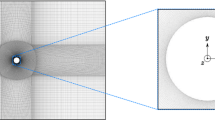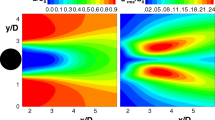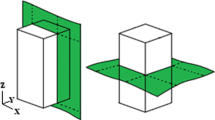Abstract
A novel method is introduced to estimate phase-averaged pressure and acceleration of the coherent structures. It is applied and validated in the near wake of a two-dimensional bluff body. The method is validated using synthetic data generated by simulating an unsteady laminar flow around a D-shaped bluff body; the effect of noise is investigated to simulate an experimental scenario. The acceleration terms, required for the closure of flow-governing equations, are accurately estimated using this approach. The findings demonstrate that the methodology outputs consistent results for the pressure field while combined with a divergence-correction scheme, based on Helmholtz decomposition, and an optimal control method using sparse sensor measurements. The approach is later validated on experimental data obtained in the turbulent wake of a bluff body by means of “Particle Image Velocimetry” (PIV). Triple-decomposed flow fields are provided as input, where triple-decomposition refers to the instantaneous flow fields split into a mean flow, coherent and incoherent structures. The coherent structures are extracted using the method of “Proper Orthogonal Decomposition” (POD). Coherent lift coefficients, estimated using integral budgets of momentum, remain within the sensor-measured range, whereas coherent drag coefficients show excellent agreement. Moreover, a significant reduction in the residuals, arising from the balance of the flow-governing equations, is achieved. Although the temporal information is lost when computing POD modes, the proposed method is able to recover it and estimate the pressure. Accordingly, the method can be extended to any time-dependant modal decomposition, thereby providing a low-cost alternative to expensive “time-resolved” PIV (tr-PIV) measurements.



















Similar content being viewed by others
Data availibility
The data supporting this study’s findings are available upon request from the corresponding author.
References
Baj P, Buxton OR (2017) Interscale energy transfer in the merger of wakes of a multiscale array of rectangular cylinders. Phys Rev Fluids 2(11):114607
Baj P, Bruce PJ, Buxton OR (2015) The triple decomposition of a fluctuating velocity field in a multiscale flow. Phys Fluids 27(7):075104
Bearman P (1965) Investigation of the flow behind a two-dimensional model with a blunt trailing edge and fitted with splitter plates. J Fluid Mech 21(2):241–255
Bearman P (1997) Near wake flows behind two-and three-dimensional bluff bodies. J Wind Eng Ind Aerodyn 69:33–54
Bearman PW, Owen JC (1998) Reduction of bluff-body drag and suppression of vortex shedding by the introduction of wavy separation lines. J Fluids Struct 12(1):123–130
Berkooz G, Holmes P, Lumley JL (1993) The proper orthogonal decomposition in the analysis of turbulent flows. Annu Rev Fluid Mech 25(1):539–575
Braza M, Perrin R, Hoarau Y (2006) Turbulence properties in the cylinder wake at high Reynolds numbers. J Fluids Struct 22(6–7):757–771
Brindise MC, Vlachos PP (2017) Proper orthogonal decomposition truncation method for data denoising and order reduction. Exp Fluids 58(4):1–18
Charonko JJ, King CV, Smith BL, Vlachos PP (2010) Assessment of pressure field calculations from particle image velocimetry measurements. Meas Sci Tech 21(10):105401
Chartrand R (2011) Numerical differentiation of noisy, nonsmooth data. International Scholarly Research Notices, 2011
Choi H, Jeon W-P, Kim J (2008) Control of flow over a bluff body. Annu Rev Fluid Mech 40:113–139
Colombié A, Laroche E, Chedevergne F, Manceau R, Duchaine F, Gicquel L (2021) Large-eddy-simulation-based analysis of Reynolds-stress budgets for a round impinging jet. Phys Fluids 33(11):115109
Dalla Longa L, Morgans A, Dahan J (2017) Reducing the pressure drag of a d-shaped bluff body using linear feedback control. Theor Comput Fluid Dyn 31(5):567–577
Darekar RM, Sherwin SJ (2001) Flow past a square-section cylinder with a wavy stagnation face. J Fluid Mech 426:263–295
de Kat R, Ganapathisubramani B (2012) Pressure from particle image velocimetry for convective flows: a Taylor’s hypothesis approach. Meas Sci Tech 24(2):024002
De Kat R, Van Oudheusden B (2012) Instantaneous planar pressure determination from PIV in turbulent flow. Exp Fluids 52(5):1089–1106
Del Álamo JC, Jiménez J (2009) Estimation of turbulent convection velocities and corrections to taylor’s approximation. J Fluid Mech 640:5–26
Dubief Y, Delcayre F (2000) On coherent-vortex identification in turbulence. J Turbul 1(1):011
Feng L-H, Ran L-K (2018) Wavelet multi-scale analysis of the circular cylinder wake under synthetic jets control. Int J Heat Fluid Flow 69:73–82
Fluent A (2013) ANSYS fluent theory guide 15.0. Inc, Canonsburg, PA
Foucaut J-M, Stanislas M (2002) Some considerations on the accuracy and frequency response of some derivative filters applied to particle image velocimetry vector fields. Meas Sci Tech 13(7):1058
Foucaut J-M, Carlier J, Stanislas M (2004) Piv optimization for the study of turbulent flow using spectral analysis. Meas Sci Technol 15(6):1046
Ganta N, Mahato B, Bhumkar Y. G (2019) Analysis of sound generation by flow past a circular cylinder performing rotary oscillations using direct simulation approach. Phys Fluids, 31(2)
Garcia D (2011) A fast all-in-one method for automated post-processing of piv data. Exp Fluids 50(5):1247–1259
Ghaemi S, Ragni D, Scarano F (2012) PIV-based pressure fluctuations in the turbulent boundary layer. Exp Fluids 53(6):1823–1840
Graftieaux L, Michard M, Grosjean N (2001) Combining piv, pod and vortex identification algorithms for the study of unsteady turbulent swirling flows. Meas Sci Technol 12(9):1422
He C, Liu Y, Gan L (2020) Instantaneous pressure determination from unsteady velocity fields using adjoint-based sequential data assimilation. Phys Fluids 32(3):035101
Heller J, Henrion D, Pajdla T (2014) Stable radial distortion calibration by polynomial matrix inequalities programming. In Asian Conference on Computer Vision, pp 307–321. Springer
Jeon YJ, Gomit G, Earl T, Chatellier L, David L (2018) Sequential least-square reconstruction of instantaneous pressure field around a body from TR-PIV. Exp Fluids 59(2):27
Kankanwadi KS, Buxton OR (2020) Turbulent entrainment into a cylinder wake from a turbulent background. J Fluid Mech 905:A35
Kim K, Lee M, Yoon S, Boo J, Chun H (2002) Phase averaged velocity field in the near wake of a square cylinder obtained by a PIV method. J Vis 5(1):29–36
Knowles I, Renka RJ (2014) Methods for numerical differentiation of noisy data. Electron J Differ Equ 21:235–246
Konstantinidis E, Balabani S, Yianneskis M (2005) Conditional averaging of PIV plane wake data using a cross-correlation approach. Exp Fluids 39(1):38–47
Kurtulus D, Scarano F, David L (2007) Unsteady aerodynamic forces estimation on a square cylinder by TR-PIV. Exp. Fluids 42(2):185–196
Lemke M, Sesterhenn J (2016) Adjoint based pressure determination from PIV-data validation with synthetic PIV measurements. Eur J Mech B Fluids 58:29–38
McClure J, Yarusevych S (2017) Optimization of planar PIV-based pressure estimates in laminar and turbulent wakes. Exp. Fluids 58(5):62
McClure J, Yarusevych S (2019) Planar momentum balance in three-dimensional flows: applications to load estimation. Exp Fluids 60(3):41
Nekkanti A, Schmidt OT (2021) Frequency-time analysis, low-rank reconstruction and denoising of turbulent flows using spod. J Fluid Mech 926:26
Noack BR, Papas P, Monkewitz PA (2005) The need for a pressure-term representation in empirical Galerkin models of incompressible shear flows. J Fluid Mech 523:339–365
Pan Z, Whitehead J, Thomson S, Truscott T (2016) Error propagation dynamics of PIV-based pressure field calculations: How well does the pressure Poisson solver perform inherently? Meas Sci Tech 27(8):084012
Passaggia P-Y, Mazellier N, Kourta A (2021) Aerodynamic drag modification induced by free-stream turbulence effects on a simplified road vehicle. Phys Fluids 33(10):105108
Pastoor M, Henning L, Noack BR, King R, Tadmor G (2008) Feedback shear layer control for bluff body drag reduction. J Fluid Mech 608:161–196
Perrin R, Braza M, Cid E, Cazin S, Moradei F, Barthet A, Sevrain A, Hoarau Y (2005) Near-wake turbulence properties in the high reynolds incompressible flow around a circular cylinder by 2c and 3c piv. In: Engineering turbulence modelling and experiments 6, pp 441–450. Elsevier
Podvin B, Pellerin S, Fraigneau Y, Evrard A, Cadot O (2020) Proper orthogonal decomposition analysis and modelling of the wake deviation behind a squareback ahmed body. Phys Rev Fluids 5(6):064612
Portela FA, Papadakis G, Vassilicos J (2018) Turbulence dissipation and the role of coherent structures in the near wake of a square prism. Phys Rev Fluids 3(12):124609
Portela FA, Papadakis G, Vassilicos J (2020) The role of coherent structures and inhomogeneity in near-field interscale turbulent energy transfers. J Fluid Mech 896:A16
Raffel M, Willert CE, Scarano F, Kähler CJ, Wereley ST, Kompenhans J (2018) Particle image velocimetry: a practical guide. Springer
Ren J, Mao X, Fu S (2021) Image-based flow decomposition using empirical wavelet transform. J Fluid Mech 906:A22
Reynolds W, Hussain A (1972) The mechanics of an organized wave in turbulent shear flow. Part 3. Theoretical models and comparisons with experiments. J Fluid Mech 54(2):263–288
Roshko A (1954) On the drag and shedding frequency of two-dimensional bluff bodies
Roshko A (1955) On the wake and drag of bluff bodies. J Aeronaut Sci 22(2):124–132
Saha AK, Muralidhar K, Biswas G (2000) Vortex structures and kinetic energy budget in two-dimensional flow past a square cylinder. Comput Fluids 29(6):669–694
Schmid PJ (2010) Dynamic mode decomposition of numerical and experimental data. J Fluid Mech 656:5–28
Shanmughan R, Passaggia P-Y, Mazellier N, Kourta A (2020) Optimal pressure reconstruction based on planar particle image velocimetry and sparse sensor measurements. Exp Fluids 61(11):1–19
Shaqarin T, Oswald P, Noack B, Semaan R (2021) Drag reduction of a d-shaped bluff-body using linear parameter varying control. Phys Fluids 33(7):077108
Stella F, Mazellier N, Kourta A (2017) Scaling of separated shear layers: an investigation of mass entrainment. J Fluid Mech 826:851–887
Sturm P (2013) Some lecture notes on geometric computer vision. University Lecture
Sun X, Yu C, Rinoshika A, Li L, Zheng Y (2018) Phase averaging on square cylinder wake based on wavelet analysis. In: 2018 International conference on wavelet analysis and pattern recognition (ICWAPR), pp 168–174. IEEE
Tombazis N, Bearman P (1997) A study of three-dimensional aspects of vortex shedding from a bluff body with a mild geometric disturbance. J Fluid Mech 330:85–112
Tröltzsch F (2010) Optimal control of partial differential equations: theory, methods, and applications, vol 112. American Mathematical Soc.,
Tronchin T, David L, Farcy A (2015) Loads and pressure evaluation of the flow around a flapping wing from instantaneous 3D velocity measurements. Exp Fluids 56(1):7
Tropea C, Yarin AL, Foss JF et al (2007) Springer handbook of experimental fluid mechanics, vol 1. Springer
Van Oudheusden B (2013) PIV-based pressure measurement. Meas Sci Tech 24(3):032001
Van Oudheusden B, Scarano F, Van Hinsberg N, Watt D (2005) Phase-resolved characterization of vortex shedding in the near wake of a square-section cylinder at incidence. Exp Fluids 39(1):86–98
Vétel J, Garon A, Pelletier D (2011) Denoising methods for time-resolved PIV measurements. Exp Fluids 51(4):893–916
Villegas A, Diez F (2014) Evaluation of unsteady pressure fields and forces in rotating airfoils from time-resolved PIV. Exp Fluids 55(4):1–17
Wang H, Gao Q, Feng L, Wei R, Wang J (2015) Proper orthogonal decomposition based outlier correction for PIV data. Exp Fluids 56(2):1–15
Wang C, Gao Q, Wang H, Wei R, Li T, Wang J (2016) Divergence-free smoothing for volumetric PIV data. Exp Fluids 57(1):1–23
Wieneke B (2017) PIV anisotropic denoising using uncertainty quantification. Exp Fluids 58(8):1–10
Williamson CH (1989) Oblique and parallel modes of vortex shedding in the wake of a circular cylinder at low Reynolds numbers. J Fluid Mech 206:579–627
Williamson CH (1996) Vortex dynamics in the cylinder wake. Annu Rev Fluid Mech 28(1):477–539
Yang B, Morse AP, Shaw RH, Paw KTU (2006) Large-eddy simulation of turbulent flow across a forest edge Part ii: 806 momentum and turbulent kinetic energy budgets. Bound Layer Meteorol 121:433–457
Zaman K, Hussain A (1981) Taylor hypothesis and large-scale coherent structures. J Fluid Mech 112:379–396
Zhang Q, Liu Y, Wang S (2014) The identification of coherent structures using proper orthogonal decomposition and dynamic mode decomposition. J Fluids Struct 49:53–72
Acknowledgements
The authors express gratitude for the technical support offered by Stéphane Loyer, PRISME Laboratory, for the experiments.
Funding
The authors acknowledge the support by the Agence Nationale de la Recherche (ANR) through the Investissements d’Avenir program under the Labex CAPRYSSES Project (ANR-11-LABX-0006-01) and the European Union FEDER (EX010666).
Author information
Authors and Affiliations
Contributions
RS performed the experiments and the calculations, prepared the figures and wrote the manuscript. PYP helped with the theory and analysis, drafted the research and corrected the manuscript. NM and AK also outlined the study and helped with the analysis and manuscript. All authors reviewed the manuscript.
Corresponding author
Ethics declarations
Conflict of interest
The authors report no Conflict of interest.
Additional information
Publisher's Note
Springer Nature remains neutral with regard to jurisdictional claims in published maps and institutional affiliations.
Appendix
Appendix
1.1 2D Divergence correction
The divergence-free correction is based on the Helmholtz decomposition, which for a velocity vector reads:
The vector potential \({\tilde{\mathbf {\psi }}}\) is divergence-free by construction. For a two-dimensional incompressible rotational flow, the scalar potential part vanishes and the vector potential becomes \({\tilde{\mathbf {\psi }}}=(0,0,{\tilde{\psi }}_{z})\). Hence, the velocity components are given by \(({\tilde{u}},{\tilde{v}},0)=\left( {\partial {\tilde{\psi }}_{z}}/{\partial y},-{\partial {\tilde{\psi }}_{z}}/{\partial x},0\right) ,\) where the vector potential becomes the stream function. Equation (22) can be rewritten as \(\nabla \times {\tilde{\textbf{u}}}=-\varDelta {\tilde{\psi }}_{z}.\) The corrected velocity vector is obtained by solving the Poisson equation for stream function with Neumann boundary conditions.
1.2 Optimal control
The method is an optimisation problem with an objective to match the estimated pressure to the sparsely measured pressure, for example: using pressure sensors (Shanmughan et al. 2020). Then, the cost function takes the form
where \(\varphi \) and the subscript c refer to the control applied on the boundary and the computed values, respectively. When considering phase-averaged pressure, the state constraints read,
which are the Poisson equation and Neumann boundary conditions respectively for the phase-averaged pressure. Then, the Lagrangian function, using the formal Lagrange multiplier method (Tröltzsch 2010), may be formulated as,
The objective then is to minimise \({\mathcal {L}} (P,\varphi ,\lambda ^+,\varphi ^+)\), i.e. \({\mathcal {D}}_{{\tilde{p}}}{\mathcal {L}}=0\) and \({\mathcal {D}}_{\varphi }{\mathcal {L}}=0\), where \({\mathcal {D}}\) represents the Fréchet derivative. From the former, the adjoint state equations can be derived as,
and from the latter, the optimal solution for the control is found as
A first guess of the constant arising out of the inversion of the Poisson equation is computed as the average difference between the estimated and the true pressure. It is then subtracted from the estimated pressure prior to the application of control and updated iteratively. The Neumann boundary conditions are corrected until the estimate converges to the true pressure.
Rights and permissions
Springer Nature or its licensor (e.g. a society or other partner) holds exclusive rights to this article under a publishing agreement with the author(s) or other rightsholder(s); author self-archiving of the accepted manuscript version of this article is solely governed by the terms of such publishing agreement and applicable law.
About this article
Cite this article
Shanmughan, R., Passaggia, PY., Mazellier, N. et al. Coherent pressure and acceleration estimation from triply decomposed turbulent bluff-body wakes. Exp Fluids 65, 53 (2024). https://doi.org/10.1007/s00348-024-03774-4
Received:
Revised:
Accepted:
Published:
DOI: https://doi.org/10.1007/s00348-024-03774-4





